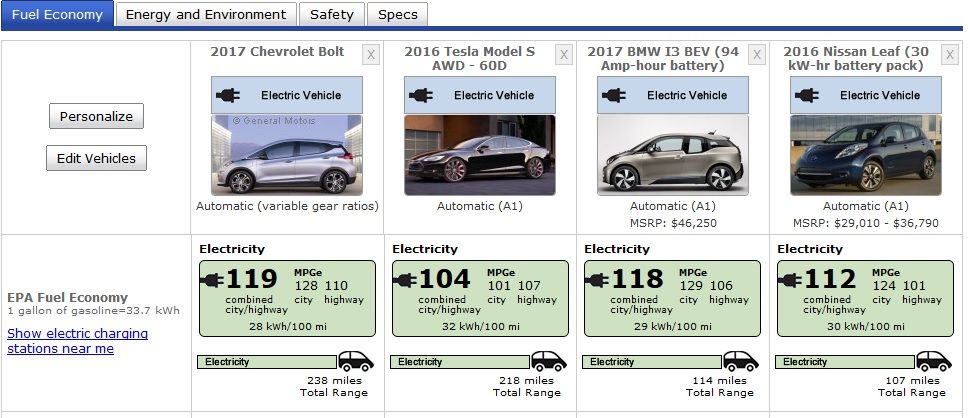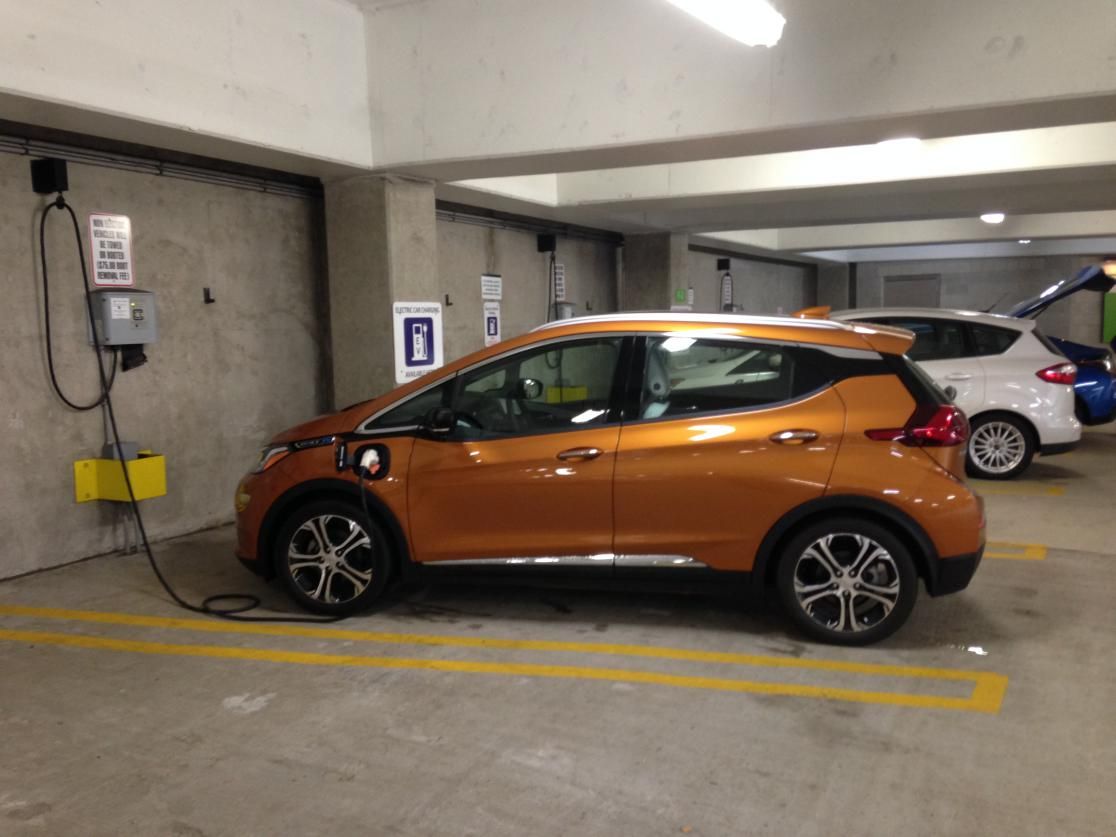Hmmm... Try plugging in the 2017 BMW i3 BEV (60 amp-hour battery)... It gets 27 kWh per 100 miles, 111 MPGe Highway, and 137 MPGe City according to the EPA.
Whoops, missed that. Ok, efficiency king for vehicles with at least a 60 kWh battery.
You can install our site as a web app on your iOS device by utilizing the Add to Home Screen feature in Safari. Please see this thread for more details on this.
Note: This feature may not be available in some browsers.
Hmmm... Try plugging in the 2017 BMW i3 BEV (60 amp-hour battery)... It gets 27 kWh per 100 miles, 111 MPGe Highway, and 137 MPGe City according to the EPA.
Hmmm... Try plugging in the 2017 BMW i3 BEV (60 amp-hour battery)... It gets 27 kWh per 100 miles, 111 MPGe Highway, and 137 MPGe City according to the EPA.
Most efficient highway EPA rating for a BEV with a combined EV range of over 81 miles.
The Bolt is (officially) the most efficient highway cruiser EV. And overall efficiency king as well.
Most efficient highway EPA rating for a BEV with a combined EV range of over 81 miles.
The Bolt EV has better highway MPGe than the 2017 BMW i3 that has the bigger 33 kWh battery. The old i3 was 111 MPGe and the new one is 106 MPGe highway.
Yes. One of several arguments to buy something else instead. I'd be partial to the Fiat 500e if the BOLT and Model ☰ didn't exist.The BMW 60ah has the size and range of the Spark EV, but is priced 70% higher.
The fact it's light weight gives it good city MPGe doesn't fix it's lack of range. So it saves 10 cents a day in electricity, that's simply not significant when compared to all the drawbacks.
Hey, you're probably not the only one.I have a confession to make. The looks are starting to grow on me.
I will be terminating my account in shame. It was a pleasure discussing things with you all.

For people interested in real world numbers, looking at the energy consumption on the screen (Wh/mi or mi/Wh) while going a certain speed will be most telling. Not sure if the Bolt will have such a screen though.Oh, I have no doubt that a Model S is more slippery than a Bolt.
However, not long ago, many folk said the Bolt could NEVER get 200 miles highway range because it's tragically lousy aero (Same Cd as a 2002 Corvette Z06) would trash it's highway numbers.
At that point, I mentioned that Cd is neither CdA nor is it the whole story on efficiency.
People get caught up numbers who don't necessarily know what effect the numbers have, or knowing all the variables that come into play.
I thought it would look good in a solid color all along. The multishaded, streaked, and bedazzled gray that GM chose to debut the final car design in was simply horrible. Still, I remain confused as to why traditional automobile manufacturers seem to have all got together and decided some time ago that electric cars must all be: BLACK, WHITE, SILVER, BLUE, or ORANGE. I don't believe any of them have been offered in GREEN since the crushing and shredding of the Honda EV Plus years ago. Just about NONE of them have been offered in RED.Hey, you're probably not the only one.
Another real world shot of a Bolt. Orange looks better than I thought it would.

Having an electric motor with nearly twice the power probably doesn't help the Model S either.Mine matches the 238 mile range.
Compare Side-by-Side
However, look at the highway MPGe. Better aero than the Model S 60, or just more efficient use of an electric motor?
Agreed. It's just bizarre that you can't get a BEV or PHEV in green. I do really like the shade of red on my 2011 Volt but I'm going with orange on the Bolt EV.I remain confused as to why traditional automobile manufacturers seem to have all got together and decided some time ago that electric cars must all be: BLACK, WHITE, SILVER, BLUE, or ORANGE. I don't believe any of them have been offered in GREEN since the crushing and shredding of the Honda EV Plus years ago. Just about NONE of them have been offered in RED.
Interesting. I had crunched the Bolt number but hadn't thought to figure out the S60 and S60D numbers.Looking at charging efficiency, from the EPA numbers, I work out:
Bolt: 67.4 kWh to fully charge
S60: 71.5 kWh to fully charge
S60D: 70.6 kWh to fully charge
It makes no sense. The Bolt just has a fixed ratio reduction gear like a Tesla or LEAF.Variable gear ratios? What is with that?
The BOLT uses a 150 kW motor. That works out to 201.153 HP. Traditional automobile manufacturers like to limit the horsepower and torque output of their electric motors so that they can use off-the-shelf transmission components in the build. Note that the SPARK EV has 327 lb-ft torque (at least one report said 400 lb-ft torque for an earlier version) compared to only 266 lb-ft torque for the BOLT (I suspect the SPARK EV was dialed back a bit to protect its transmission). GM probably wants to make sure the BOLT does not smoke their entire ICE driven product line.Variable gear ratios? What is with that?
This article appeared in the University Herald Reporter on 9/15/2016, written by Sarene Mae Butao. A video by Roadshow features the Chevy Bolt being driven down Highway 1 in California testing out the car and the mileage range.
That's a whole lot of supposition going on...The BOLT uses a 150 kW motor. That works out to 201.153 HP. Traditional automobile manufacturers like to limit the horsepower and torque output of their electric motors so that they can use off-the-shelf transmission components in the build. Note that the SPARK EV has 327 lb-ft torque (at least one report said 400 lb-ft torque for an earlier version) compared to only 266 lb-ft torque for the BOLT (I suspect the SPARK EV was dialed back a bit to protect its transmission). GM probably wants to make sure the BOLT does not smoke their entire ICE driven product line.
I wish Tesla would provide as much information on the M3 as there is available on the Bolt.The premise of that article is absurd. We know very little about the Model 3 at this point, so far in advance of it going into production. It is far too early to make any kind of useful comparison.
I wish Tesla would provide as much information on the M3 as there is available on the Bolt.
Chevrolet Bolt - Wikipedia, the free encyclopedia


